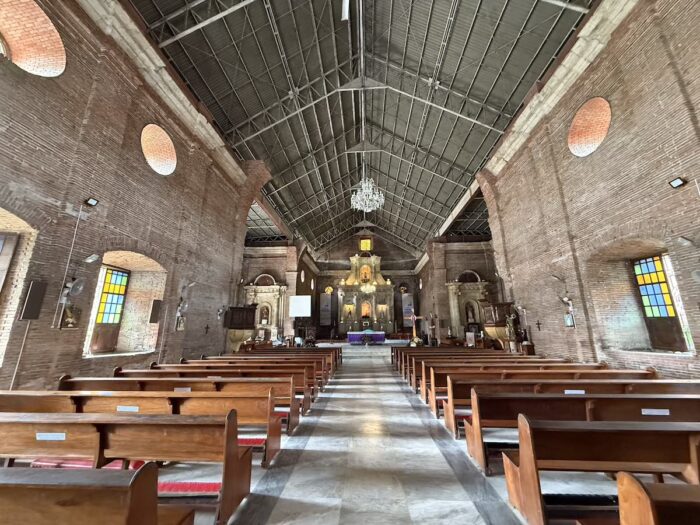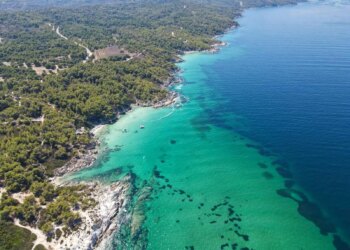We touched down at Iloilo Worldwide Airport simply because the solar started to rise, casting a gentle golden hue throughout the morning sky round 6 AM. With a while to spare earlier than our subsequent deliberate exercise, our tour information seized the chance to introduce us to some close by points of interest. One of many gems that welcomed early guests was the charming Santa Barbara Parish Church, a historic web site identified for its spectacular structure and serene ambiance.

Santa Barbara Iloilo Parish Church and Convent
Santa Barbara Church and Convent in Iloilo is a surprising and traditionally vital landmark within the Philippines. Inbuilt 1845, it showcases Baroque Renaissance structure that mixes simplicity with magnificence. This church performed an important position within the 1898 revolution towards Spain, serving because the headquarters of the revolutionary authorities within the Visayan area.
Guests to Santa Barbara can discover the church’s connection to the Philippine battle for independence and consider the close by statue of Normal Martin Teofilo Delgado, a key determine within the revolution. This web site is acknowledged as a Nationwide Historic Landmark, additional highlighting its significance within the nation’s historical past. The church can be identified for internet hosting one of many websites the place the Philippine flag was first raised exterior Luzon, marking a big occasion in historical past.
In the present day, the Santa Barbara Church continues to draw each locals and vacationers. It not solely affords perception into the previous but additionally stands as an emblem of Filipino energy and resilience. Situated simply minutes away from the airport, it’s an accessible cease for anybody within the nation’s wealthy historic material.

Pre-Spanish Period
Earlier than the arrival of the Spanish, Santa Barbara was dwelling to indigenous communities. These early inhabitants practiced agriculture and fishing, forming small, self-sufficient villages. They lived in concord with nature and used native knowledge for day-to-day actions. Orally handed traditions and folklore have been vital parts of their tradition. Commerce with different close by islands launched them to new items and concepts, laying the groundwork for future developments.
Spanish Colonial Interval
Underneath Spanish rule, Santa Barbara reworked into an organized municipality. The Spanish constructed key establishments, together with the Santa Barbara Parish Church, based in 1760. This era marked the unfold of Christianity, with the church changing into a pivotal neighborhood hub. Spanish structure influenced native constructing types. By the late nineteenth century, the church served spiritual and administrative functions, showcasing distinctive yellow sandstone development. Throughout this period, a extra structured political system took form, impacting social and financial dynamics.
Revolution towards Spanish Rule
Santa Barbara was instrumental throughout the Philippine Revolution towards Spanish rule. It served as the overall headquarters and navy hospital for revolutionary forces. Gen. Martin T. Delgado, a local of Santa Barbara, led vital revolutionary actions. Declaring the primary cry of revolution in Iloilo, the city grew to become a beacon of resistance. Celebrations of the revolution’s anniversary stay an essential cultural occasion at present. The church and convent acted as strategic bases, enhancing Santa Barbara’s historic significance as a middle of nationalist sentiments.
American Regime and World Battle II
Throughout the American regime, Santa Barbara emerged as a municipality with fashionable establishments. Training and infrastructure initiatives improved residing requirements. The Parish Church continued as an important neighborhood landmark. World Battle II introduced challenges, because the church and surrounding areas have been strategic factors. Many locals took half within the resistance towards Japanese forces. After the battle, rehabilitation and rebuilding efforts started, restoring Santa Barbara’s municipal features and historic websites. These efforts highlighted the resilience and enduring spirit of its individuals.

The Santa Barbara Church and Convent
Architectural Options
The Santa Barbara Church showcases a formidable Baroque-Renaissance design. Inbuilt 1845, the structure blends simplicity with magnificence. The facade is adorned with classical columns and complex carvings, capturing the period’s inventive spirit. Excessive ceilings and arched home windows permit pure mild to create a serene ambiance inside.
Inside, guests can admire detailed murals and ornate altars. The construction’s strong stone development displays its resilience by time. The adjoining Convent enhances the church’s type, providing a unified aesthetic. This architectural brilliance makes the location not solely a spot of worship but additionally a treasure trove for fanatics of historic and inventive design.
Spiritual Significance
Santa Barbara Church is a vital a part of the Roman Catholic custom within the area. It serves as a beacon of religion for a lot of devotees and has been an energetic parish beneath the Archdiocese of Jaro. The church performed an important position in neighborhood life, internet hosting quite a few spiritual ceremonies and occasions.
Past its day-to-day actions, the church is linked to the 1898 revolution towards Spanish rule. This connection provides one other layer to its non secular and historic significance. Pilgrims and guests alike are drawn to the church for its peaceable ambiance and its place within the wealthy tapestry of Filipino spiritual historical past.
Conservation and Restoration
Conservation efforts have helped preserve the Santa Barbara Church and Convent’s historic appeal. Through the years, restoration initiatives have centered on repairing structural injury and preserving unique options like stonework and paintings. These efforts make sure the constructing’s stability and longevity.
Native and nationwide heritage organizations work collectively to guard this Historic Heritage web site. Restoration initiatives typically obtain help from each authorities and neighborhood teams, highlighting the church’s significance to native tradition. By means of these collaborative efforts, the church and convent proceed to face as symbols of tolerating religion and historical past.

Cultural and Historic Significance
Nationwide Cultural Treasure
Santa Barbara Church and Convent gained recognition as a Nationwide Cultural Treasure in 2013. This standing highlights its architectural magnificence and significance. It showcases the Philippines’ colonial historical past by its design and supplies, that includes traditional Spanish colonial structure.
The wealthy artistry evident in its construction displays intricate stone carvings and woodwork. These options seize the essence of cultural heritage. The designation as a Nationwide Cultural Treasure helps protect these historic parts, making certain future generations respect its cultural significance.
Historic Occasions
The church was pivotal in Philippine historical past. Constructed within the 18th century, it grew to become a centerpiece for historic occasions. Taking part within the battle for independence, it served as a gathering level for revolutionaries. Normal Martin Delgado, chief of the Visayan Revolutionary Authorities, utilized the church as a strategic web site throughout the revolution.
The church hosted the primary Cry of Revolution within the Visayas towards Spanish rule. This crucial occasion symbolized the area’s resistance and need for freedom, taking part in a big position within the broader independence motion.
Handover to the Filipino Revolutionary Authorities
Santa Barbara Church holds the excellence of internet hosting the primary elevating of the Philippine Flag exterior Luzon. On November 17, 1898, it served because the venue for this vital event, marking the handover to the Filipino Revolutionary Authorities.
This occasion symbolized a pivotal shift within the area’s governance and spirit. The church’s balcony, from which the flag was unveiled, grew to become an iconic image of Filipino satisfaction and unity. This occasion continues to be celebrated for its significance in fostering nationwide id and independence aspirations.

Santa Barbara Centennial Museum
Reveals and Collections
The museum includes a various array of displays that spotlight the historic significance of Santa Barbara. Guests can discover shows that embrace images, memorabilia, and artifacts. These displays assist paint a vivid image of the town’s previous. The museum’s assortment is designed to have interaction each residents and vacationers, offering insights into how the area has developed over time. A go to to the museum affords a captivating glimpse into numerous historic intervals, enhancing the understanding of Santa Barbara’s distinctive heritage.
Artifacts and Antiquities
Artifacts and antiquities type the spine of the museum’s assortment. Objects like outdated images, historic paperwork, and on a regular basis objects from bygone eras provide a tactile connection to the previous. These items are rigorously preserved and displayed, offering context and depth to the museum’s narrative. The gathering of artifacts and memorabilia reveals the layers of historical past embedded in Santa Barbara’s improvement. Every artifact serves as a testomony to the lives and tales of those that lived in and formed the world over the centuries.

Incessantly Requested Questions
What’s the historic significance of the Santa Barbara Iloilo Parish Church and Convent?
The Santa Barbara Iloilo Parish Church and Convent holds vital historic significance because the cradle of the revolution towards Spanish colonial rule within the Philippines. It was the location the place Normal Martin Delgado of the Visayan Revolutionary Authorities convened the junta that raised the primary Cry of Revolution towards the Spaniards in 1898. The church and convent served because the headquarters for the Ilonggo Revolutionary Forces in Western Visayas throughout this pivotal interval. Architecturally, the church is a Baroque-Renaissance construction constructed between 1849 and 1878, reflecting each historic and cultural heritage. This mix of revolutionary historical past and architectural worth has led to its designation as a Nationwide Historic Landmark by the Nationwide Historic Institute.
When are the mass schedules on the Santa Barbara Iloilo Parish Church?
The mass schedules on the Santa Barbara Iloilo Parish Church are as follows:
Sundays:
- 5:30 AM – 6:30 AM
- 8:00 AM – 9:00 AM
- 5:00 PM – 6:00 PM
These occasions are constant throughout a number of sources and replicate the common Sunday mass schedule on the parish.
How can one journey to Santa Barbara Iloilo Parish Church and Convent from Iloilo Metropolis?
Touring from Iloilo Metropolis to the Santa Barbara Iloilo Parish Church and Convent is easy and could be carried out in a number of methods:
By Taxi or Non-public Automobile:
The quickest approach is by taxi or non-public automobile, which takes about 16 minutes and prices roughly P290–P350. That is probably the most handy possibility, particularly if you’re touring with a gaggle or have baggage.
By Jeepney or Bus:
You too can take a jeepney or bus from Iloilo Metropolis certain for Santa Barbara. Jeepneys and buses going to Santa Barbara can be found on the Iloilo Metropolis terminal (normally at Tagbak Terminal in Jaro). The journey usually takes 30–40 minutes, relying on site visitors.
On Foot:
Whereas technically attainable, strolling is just not really useful because of the distance (about 16–18 km) and highway situations.
As soon as in Santa Barbara, the church and convent are centrally situated and well-known, making them straightforward to search out.
Are there any notable architectural options of the Santa Barbara Iloilo Parish Church?
Sure, the Santa Barbara Iloilo Parish Church is famend for a number of notable architectural options:
- Baroque-Renaissance Model: The church is primarily constructed within the Baroque-Renaissance type, evident in its general construction and design parts.
- Cruciform Form: The church has a cruciform (cross-shaped) structure, typical of many massive Catholic church buildings.
- Neoclassical Facade: Its facade options Neoclassical parts, corresponding to 4 units of dual pilasters and symmetrical proportions.
- Dome-Formed Ceiling: One among its most excellent options is the dome-shaped ceiling, which was distinctive amongst church buildings in-built Iloilo throughout the identical interval.
- Building Supplies: The church was constructed utilizing yellow sandstone, adobe, and coral stones, with crimson bricks used for sure components, showcasing each sturdiness and aesthetic worth.
These options collectively contribute to the church’s popularity as an architectural and historic landmark in Iloilo.
Which occasions led to the ‘Cry of Santa Barbara’ and the way is it linked to the Parish Church and Convent?
The ‘Cry of Santa Barbara’ was a pivotal occasion in Philippine historical past, marking the formal begin of the revolution towards Spanish colonial rule within the Visayas area. A number of key occasions led as much as this second:
-
Unfold of Revolutionary Sentiment: Following the outbreak of the Philippine Revolution in Luzon in 1896, revolutionary fervor unfold to the Visayas. Native leaders in Iloilo, impressed by the Katipunan motion, started organizing resistance towards Spanish authorities.
-
Management of Normal Martin Delgado: Normal Martin Delgado emerged because the chief of the revolutionary forces in Iloilo. He rallied native Katipuneros and different supporters to affix the trigger for independence.
-
Gathering of Revolutionary Forces: On November 17, 1898, hundreds of Katipuneros and native leaders gathered within the city of Santa Barbara for a vital conference to debate the way forward for Panay and to formalize their resistance.
Connection to the Parish Church and Convent:
The Santa Barbara Parish Church and Convent served because the headquarters and meeting place for the revolutionary forces. It was on the balcony of the convent the place Normal Martin Delgado publicly proclaimed the revolution towards Spanish rule, elevating the Philippine flag for the primary time within the Visayas. This declaration, often called the ‘Cry of Santa Barbara,’ marked the official begin of the revolution within the area and the institution of the Federal State of the Visayas beneath the revolutionary authorities.
Thus, the Parish Church and Convent will not be solely spiritual constructions but additionally historic symbols of Filipino resistance and the search for independence within the Visayas.
Can guests take images contained in the Santa Barbara Iloilo Parish Church and are there any restrictions?
Sure, guests are usually allowed to take images contained in the Santa Barbara Iloilo Parish Church, particularly for private and non-commercial functions. Nonetheless, as with most heritage and energetic worship websites, there are some widespread restrictions:
- No images throughout Mass or spiritual ceremonies: To keep up the sanctity of the liturgy and keep away from disrupting worship, images is often discouraged or prohibited throughout ongoing Lots or particular spiritual occasions.
- Respect designated areas: Some areas, such because the altar or vestry, could also be off-limits for images until specific permission is granted by church employees.
- No flash or tripods: Use of flash and tripods could also be restricted to guard artworks and keep away from disturbance.
- Business or skilled shoots: For skilled, business, or pre-nuptial shoots, prior permission from the parish workplace is normally required, and there could also be related charges.
As insurance policies could change or have particular native nuances, it’s all the time greatest to verify with the parish workplace or employees upon arrival for probably the most up-to-date pointers relating to images.
Iloilo Journey Tour Packages You Ought to Strive
Observe and Subscribe to OutofTownBlog.com on Fb, Twitter, Instagram, Pinterest, and YouTube for extra Journey associated updates.
Learn:













